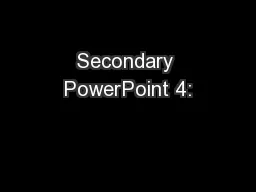

The Voting Process Who is responsible for running territorial elections in Yukon Elections in Yukon are conducted by Elections Yukon an independent Office of the Legislative Assembly under the direction of the ID: 604386
Download Presentation The PPT/PDF document "Secondary PowerPoint 4:" is the property of its rightful owner. Permission is granted to download and print the materials on this web site for personal, non-commercial use only, and to display it on your personal computer provided you do not modify the materials and that you retain all copyright notices contained in the materials. By downloading content from our website, you accept the terms of this agreement.
Slide1
Secondary PowerPoint 4:
The Voting ProcessSlide2
Who is responsible for running territorial elections in Yukon?
Elections in Yukon are conducted by
Elections Yukon
, an independent Office of the Legislative Assembly, under the direction of the Chief Electoral Officer. This ensures that elections are conducted in a fair and unbiased manner.www.electionsyk.caSlide3
Who is eligible to vote?
You are qualified to vote in a Yukon territorial election if:
You are a Canadian citizen;
You are 18 years of age;
You have been a resident in Yukon for the past 12 months.Slide4
What must I do to vote?
Voting is easier to do when you are already on the
list of electors
(a list of all people who can vote in the next election)
. Earlier this year, election officials went door-to-door to collect names of eligible voters for the list of electors. This is called enumeration.If you were missed during enumeration, you can still be added to the list of electors.Slide5
What do I need in order to vote?
If your name is not on the
list of electors
, you must show
identification. You have four options:One piece of government-issued photo ID that shows your name and current address (e.g., driver’s licence, Certificate of Indian Status Card, passport, fishing or hunting licence).Two pieces of identification that both show your name and current address (e.g., personal cheque, credit card statement, income tax document, lease agreement, utility bill).If you are unable to provide ID, another elector from your electoral district can vouch for you.If you are unable to provide ID or appoint an elector to vouch for you,
you can
sign a declaration
to declare your name and address. Slide6
Where do I vote?
Each electoral district is divided into defined geographic areas called
polling divisions
.
Voters living in each polling division must vote at a designated pollingplace.You can find out where to vote by going to the Elections Yukonwebsite, by calling
them or checking in a local newspaperSlide7
How does the voting process work?
When you arrive at your
polling place
, a
poll clerk greets you and directs you to the right table.Provide your name and address so that the poll clerk can check to see if your name is on the list of electors. If your name is not on the list, you will need to show the poll clerk government-issued ID with your name to receive a ballot. If you do not have ID, another elector from your electoral district can vouch for you or you can sign a declaration.The
deputy returning officer
will give you a folded
ballot
that has been initialled by an election official.
You will take your ballot behind a
voting screen
,
mark your ballot
for one candidate and
refold your ballot
for privacy.
Afterwards, the deputy returning officer will check that the folded ballot has the correct initials. The DRO puts the ballot in the
ballot box
.Slide8
How do I mark my ballot?
A
ballot
lists the names of the candidates running in your electoral district and their party affiliation.The voter must clearly mark the ballot with a single preference for it to be valid (e.g., checkmark, X, shading in).Voting is done by secret ballot. No one except the voter knows the choice that was made.Slide9
Rejected and Spoiled Ballots
A
rejected ballot
is
a ballot that cannot be counted because it was not properly marked (e.g., if someone voted for more than one candidate).A voter may also choose to use their vote to express their unhappiness with the options given. This is called a declined ballot. This is done by returning your ballot to the deputy returning officer and confirming that you wish to decline your ballot.Slide10
What are advance polls?
Electors who are away, busy or unable to vote on polling day have the option of
advance polls
.
Advance polls are open for two days before polling day.Slide11
Final Thoughts
How will
you make your decision about who to vote for?
How do you know if you are ready to vote
?Why is voting important?How can you encourage eligible voters that you know to cast their ballot?